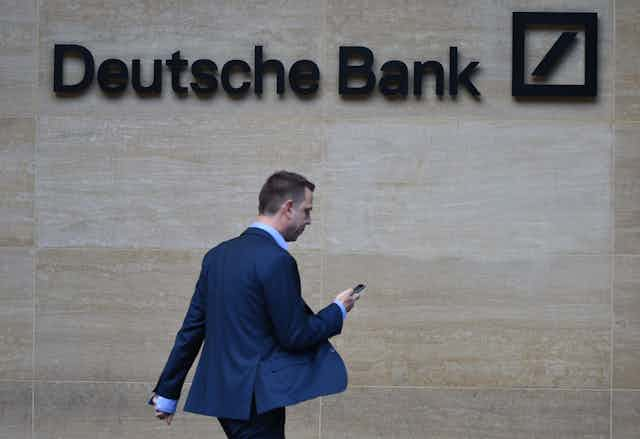Deutsche Bank’s share price plummeted following a US$14 billion demand from the US Department of Justice for mis-selling mortgage-backed securities. On the surface it’s a hefty fine – and Deutsche is challenging it – but it should not be life threatening. The bank has been around for 140 years. Last year revenue was €34 billion; the bank lost €6.8 billion, while holding €1.6 trillion in assets and its equity was worth €62.7 billion. So a one-off shock would be unsettling, but can be absorbed.
Yet the share price drop shows that investors do not share this confidence. This reflects the fact that even a bank (or other financial institution) with a sound balance sheet has the inherent risk of a run, with everyone dashing to sell their stocks or withdraw their funds at the same time. It is not just a matter of having assets outweigh liabilities, but having assets accessible when the liabilities are due.
Take my pension fund, USS, for example. In terms of assets, it is one of the largest in the world at £50 billion. While the USS management has done a brilliant job on that side of the balance sheet, the other side now has liabilities of £60 billion (mainly due to a drop in interest rates). This is not unusual in the world of pensions and I don’t lose sleep over this shortfall.

The reason is that if everyone on the books continues to make their contributions to the fund and new members keep joining, then it should continue to function. If everyone else suddenly started withdrawing today, however, then I should rationally join the queue since there would be nothing left by the time I retire. What helps stop these runs from happening for pension funds is the slow, costly one-way withdrawal process.
Self-fulfilling prophecies
For many financial institutions there are no such barriers, so both a run and stability are self-fulfilling prophecies. Bernie Madoff’s fund, for example, sustained itself for decades despite a huge shortfall. It could even have kept going for at least a decade more if the true Ponzi nature of the fund wasn’t revealed.
What may surprise many is that the potential of a run and business-as-usual is equally possible, even if the institution’s assets exceed its liabilities and it isn’t set up in a Ponzi-like scheme. The problem exists because liabilities can be demanded quickly and assets are illiquid – that is, the process of selling an asset can take a while to find a buyer (as with a house) or the market is small enough that when people know that an institution must sell certain assets, it lowers what people are willing to pay for them.
These two possible scenarios also exist with Deutsche Bank where there is a real risk of a run, not so much by small depositors but by other institutions. It need not even be a hedge fund withdrawing investments – as recently precipitated an 8% drop in the bank’s stock – but even something as simple as short-term loans not being renewed. These runs can as much be triggered by external events, like receiving a large fine, as from an internal announcement indicating that the business would not be profitable in the long term.

So, even though Deutsche Bank’s financials appear to be sound, there are real dangers from runs. In the financial industry, things are also really not as clear as the balance sheet, unless it’s a large pensions fund. Very few, if any, know the exact state of an institution’s assets, liabilities, and liquidity. If regulators are not among the few, it could take them time to learn. Thus, there is often a strong asymmetry of information that only worsens the situation.
Then there is a risk of contagion. A run can spread from Deutsche Bank to other financial institutions. My research with Surajeet Chakravarty and Miguel Fonseca published in the European Economic Review in 2014 shows just such an effect can happen. We found a run can spread even if the balance sheet of another bank does not have a direct connection to the bank undergoing a run.
Again, it’s a self-fulfilling prophecy. If depositors at a second bank think there is an indirect connection, then indeed there will be. So it is rational for depositors to run on the second bank simply because they believe others will do so. It is therefore important for regulators and the institutions themselves to try to stop these fears from forming, but once a crisis has started actions must be chosen with care – any half-way measure can increase panic rather than alleviate it.

